The Best Content Analytics Tools: 7 Essential Options for Marketers
Written by David L Hicks – April 25th, 2025
Data and information are vital to developing an organization’s content strategy and workflow. Content developers and marketers can use data to analyze their content’s performance and build a strategy to improve it. As the importance of data continues to rise, data analytics will also grow. The global data analytics market is projected to exceed $140 billion in 2025.
Content analytics tools can simplify content development and strategy by providing detailed metrics and reports that give users new insights into their content, help them stay ahead of the competition, and improve their ROI.
This guide will walk you through the seven best content analytics tools to improve your content analysis and reporting. In addition to learning about these tools, you’ll also learn about the benefits of having a content analytics tool in your arsenal and strategies to maximize your selection.
Table of Contents
ToggleWhat is Content Analytics?
Content analytics is the process of measuring, analyzing, and assessing data related to your content and content marketing performance. The data can consist of a wide range of points that give you a complete understanding of how your content is performing.
Key metrics most organizations use when it comes to their content analytics, marketing campaign performance, and other marketing data include the following:
- Page views
- Clicks
- Page session
- Social shares
- Conversion rates
- User behavior
Another key aspect of content analytics is presenting the data clearly and concisely for various groups within your organization, which helps improve your marketing performance.
What is a Content Analytics Tool?
A content analytics tool makes compiling content performance data easier. Currently, most tools come with various features that help compile, analyze, and present data.
In addition to making data intake, analysis, and presentation easier, they help organizations make better decisions with the data’s metrics results. Organizations can better understand how their content resonates with audiences and contributes to business goals, which is extremely important. With the right tool(s) and processes in place, you will definitely improve your ROI. Content analytics tools are just as important as other content strategy centric tools including content calendar tools.
7 Best Content Analytics Tools
As you research the best content analytics tools, start with the list of the seven best tools presented below.
1. Ahrefs

Summary
Ahrefs is a popular SEO-centric rank-tracking software tool offering many content analytics and reporting features. It offers keyword research functions, website auditing, backlink reporting, and ranking analysis. The Ahrefs SEO suite offers various popular SEO features, including rank tracking, which helps users improve their overall SEO knowledge and execution. In addition to the capabilities provided by Ahrefs, the software platform also offers a mobile app to monitor rankings while on the go.
Pricing Range –Free to $1,499 (Per month)
Important Note – The enterprise pricing plan is the most expensive plan within Ahrefs, at $1,499. The enterprise version requires an annual commitment.
Ahrefs – Lite, Standard, and Advanced Pricing Plans

Ahrefs – Free, Starter and Enterprise Pricing Plans
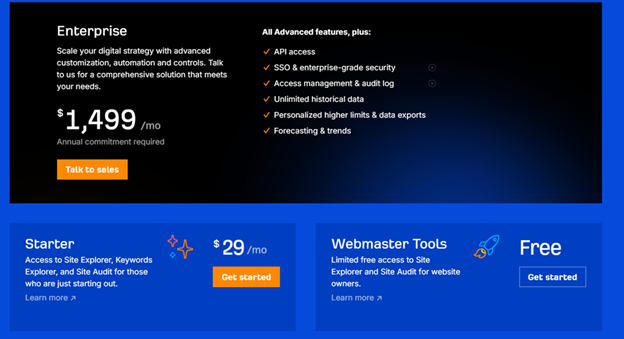
Key Features
- Keyword Explorer
- SEO Reporting Dashboard
- Content Gap Analysis
- Website Rank Tracker
- SERP Comparison Reporting
- Backlink Analysis reporting capabilities, including the following:
- Broken backlinks
- Broken links
- Outgoing links
- Link intersect reporting
Pros
- Export reporting capabilities
- Extensive reporting capabilities
- Data can be updated daily (additional price)
- Free tools include:
- Backlink Checker
- Website Authority Checker
- Keyword Generator
- Broken Link Checker
- Website Checker
- AI Writing Tool (includes AI paragraph generator and AI paragraph rewriter)
Cons
- The free version only provides limited access to Site Explorer and Site Audit for website owners.
- Limited credit allotment for Starter and Lite pricing plans
- Limited reporting data to export based on the plan selected
- The enterprise version requires an annual commitment
2. Semrush

Summary
Semrush is a digital marketing analytics tool that serves an all-in-one marketing suite with extensive SEO and analytics capabilities, including rank tracking and on-page SEO tracking. Semrush offers users tools to monitor keyword rankings, visibility, and backlinks. It also provides in-depth insights into competitor data, keyword research, and more. Although the tool’s price is higher, you can get more for your buck with their extensive offering.
Pricing Range – $139.99 to $499.00 (Per month)
Important Note – You can create a free account with Semrush. However, the free account limits your ability to pull data and use other tools.

Key Features
- Keyword Research capabilities include the following:
- Keyword gap analysis
- Organic research analysis
- Keyword generation through Keyword Magic Tool
- Competitor Analysis
- On-Page SEO
- Website Audit Capabilities
- Log File Analyzer
- On-Page SEO Checker
Pros
- Offers a free account
- Provides detailed reporting features
- PDF reporting capabilities
- Build scheduled reports
- Extensive features within the rank tracking marketing, SEO reporting, and writing areas of focus
Cons
- Overall pricing
- Additional users and add-on features will incur an additional cost
3. HubSpot
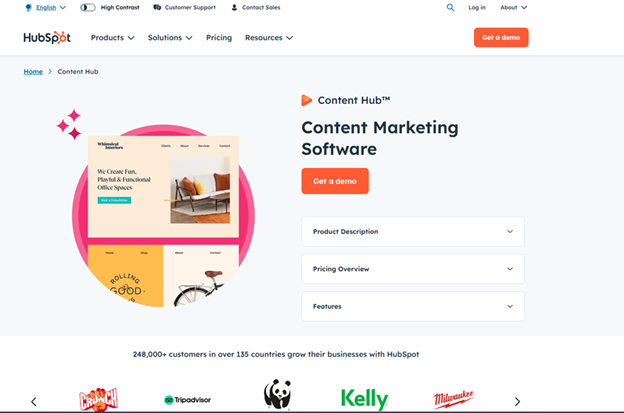
Summary
Content Hub is HubSpot’s content marketing software, which helps organizations create and scale content. What makes the tool stand out is its advanced reporting and analytics features. The Content Hub has a wide array of capabilities that will take your content to the next level. These capabilities include video and podcast hosting, advanced analytics, reporting, lead capturing, and content management.
Pricing Range – Free to $1,500 (Per month)

Key Features
- Reporting and Analytics Features including:
- Content optimization reporting
- Content generation via AI
- Lead capture features
- A/B testing capabilities
- Lead scoring capabilities
- ROI calculator
Pros
- Offers free version
- Pricing (specifically for individuals and small teams)
- Educational content library
- 24/7 Customer Support services
- Onboarding services
- Ability to build landing pages and blogs
- Omni-channel marketing automation
- AI blogging capabilities
- Managed cloud hosting
Cons
- Extensive learning cure
- Free plan features are limited
4. Google Analytics
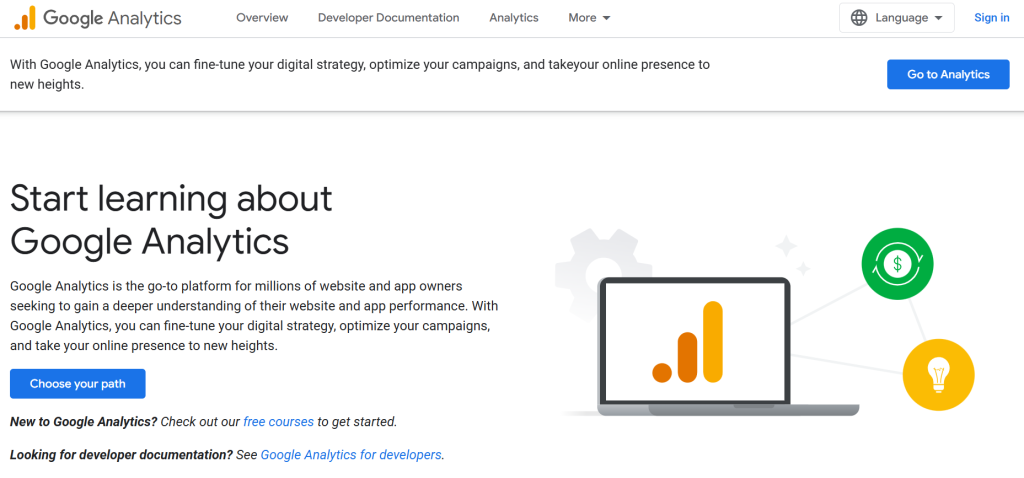
Summary
Google Analytics is a powerful web analytics service offered by Google. The service allows website owners to track and report on website content details. Key website metrics that are collected include clicks, sessions, time on the page, and social media engagement. Through Google Analytics, you can build, and export reports based on various key areas of focus, including website engagement and organic searches.
Google Analytics 4 (GA4) is the latest version. It emphasizes event-based tracking and offers enhanced machine-learning capabilities to deliver predictive insights.
Pricing Range – Free
Key Features
- Real-time user activity monitoring of site and app activity
- Predictive capabilities
- Content changes and trends insights
- Visitor engagement reports
- Audience segmentation and analysis
Pros
- Free plan
- Offers free education courses
- Ability to import data including the following:
- Custom definitions
- First party data
- Integrations with various Google solutions, including:
- Google Cloud
- Google Ads
- Salesforce Marketing Cloud Integration
- Google Search Console
- Google Ad Manager
- Regular updates and new features (Currently on version GA4)
Cons
- There is a steep learning curve for beginners
5. Sprout Social
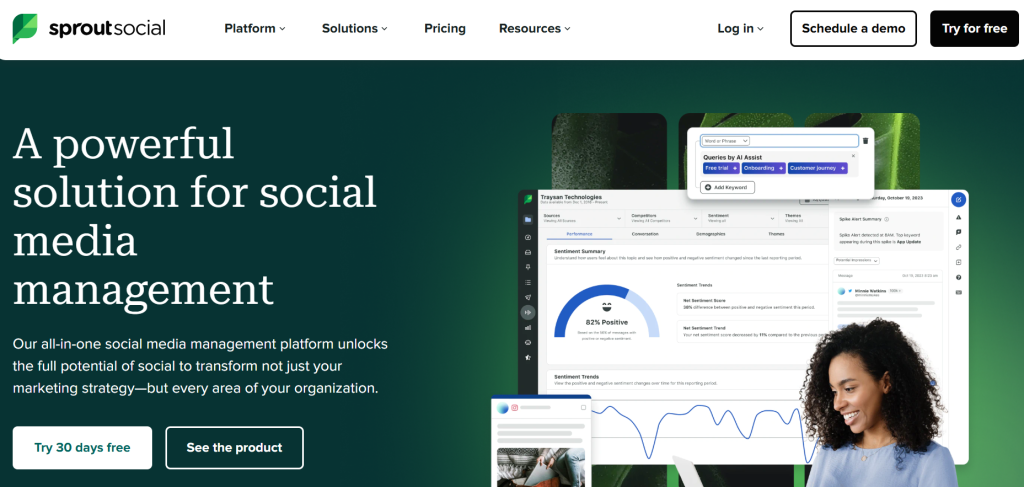
Summary
Sprout Social is a social media management platform that offers an extensive list of analytics and reporting capabilities. Chief among their features is the ability to create your own reports to cater to your organization’s needs. Besides their extensive reporting features, Social Sprout allows content marketers to use AI to generate alt text and create their social media calendars. This solution helps marketers track engagement metrics, benchmark against competitors, and understand audience demographics across multiple social channels. With the use of this tool, you’ll have no trouble getting a return on your investment.
Pricing Range – $199 to $399 (Per seat/month)
Important Note –If you prefer the Enterprise pricing plan, you must contact the Sprout Social sales team to schedule a demo and discuss pricing.
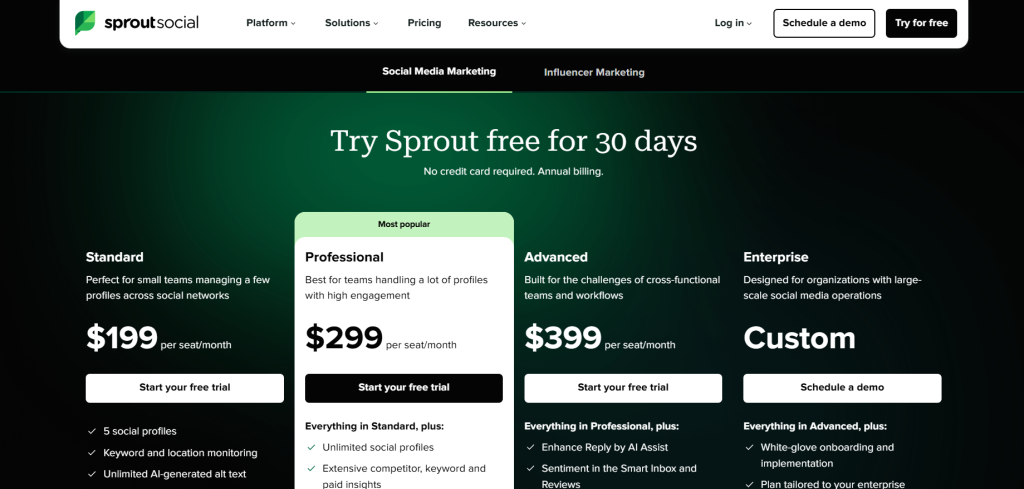
Key Features
- Keyword and location monitoring
- Group profile and post-level reporting
- Social network reports
- Cross-network group reports
- Google Analytics reports
- Unlimited AI-generated alt-text
- Message tagging
- Competitor, keyword, and paid insights
Pros
- Offers a 30-day free trial with no credit card required for the following pricing plans:
- Standard plan
- Professional plan
- Advanced plan
- Real-time keyword and brand monitoring
- Keyword reports
- Distribution/Social media platform reporting for the following:
- X (Twitter)
- Brand engagement reporting
- Retains conversion history at a minimum of 90 days
- iOs and Android inbox push notifications
Cons
- Higher price point compared to other analytics tools
- Must pay per seat/account
- No free plan available (only offers a 30-day trial)
- The standard plan comes with five social profiles
- Helpdesk integrations only available with Advanced and Enterprise pricing plans
6. Kissmetrics

Summary
Kissmetrics is an analytics product that is considered person-based, meaning it tracks human behavior across the web. Using a tool like Kissmetrics helps organizations identify and understand their content’s performance metrics. This is also great because by analyzing and understanding your content, you can make better decisions about addressing high-performing and low-performing content.
Kissmetrics offers extensive performance features, including KPI, activity, and email campaign reporting, that help you gain a full view of your content.
Pricing Range – $125.99 to $499 (Per month)
Important Note –If you prefer the Enterprise pricing plan, you must contact the Kissmetrics sales team to discuss pricing. You also have the option to build your own custom plan (pricing starts at $125.99 based on 1 million events tracked); this also involves contacting the Kissmetrics sales team.

Key Features
- Person-based analytics tracking
- KPI reporting capabilities
- Sales funnel reporting capabilities
- User search reporting capabilities
- Data retention
- Custom onboarding
Pros
- Ability to build your own limited plan at a cheaper pricing option
- Monthly event tracking capabilities
- Customer activity reporting capabilities
- A/B test reporting capabilities
- Email campaign reporting capabilities
Cons
- Higher price point compared to other analytics tools
- Both small and mid-sized team pricing plans lack extensive features
- Steeper learning curve for marketing teams
- Data exporting capabilities are not offered for the small team pricing plan
- Integrations aren’t available for the small team pricing plan
7. Parse.ly

Summary
Parse.ly is a content analytics platform for publishers, content creators, and digital media companies. Its purpose is to help organizations understand how customers interact with their content and identify opportunities for improvement. Understanding this helps organizations make better decisions about how they manage their data.
Parse.ly offers organizations an extensive list of features to help them get the most out of their reporting needs. These include an analytics dashboard that provides real-time data and the ability to view 30+ audience metrics. For organizations that want up-to-date insights into their content’s performance, Parse.ly is an excellent choice.
Pricing Range – Contacting the Parse.ly sales team and requesting a demo is required.

Key Features
- Content analytics and reporting dashboard
- Audience-centric metrics capabilities
- Marketing campaign tracking
- Audience segmentation
- Ability to create APIs to integrate recommendations into your organization’s websites
Pros
- Each pricing plan offers a generous number of seats
- Offers SSO capabilities
- Geographic segmentation
- Channel tracking
- Generative AI via content management system offering
Cons
- A demo request is required in order to obtain a pricing plan
- Features aren’t as extensive as others on the list
- No free version is available
- It only tracks three sites
For the smallest plan, historical data is only kept for 13 months; this hurts historical analysis and reporting capabilities
Content Analytics Tool Benefits
Content analytics tools offer users a wide variety of benefits, including the ability to maximize processes.
Improves Decision-Making Process
With so much data that these tools take in, they give organizations all they need to make better decisions. Content analytics tools’ data allows organizations to shrink or expand their view of how their content is performing. Management can pick and choose the most valuable metrics and how they align with their organization’s objectives. With everything at their fingertips, it makes for improved decision-making.
Identifies Top-Performing Content
Because you have so much data that you can leverage, it is easier to identify top-performing content. Identifying top-performing content also has the added benefit of understanding why content isn’t performing well. Based on the performance of your content, you can compare why one is working and why the other isn’t. For example, your blog post about AI usage may perform better than your blog post about the best AI writer tools because it’s only a week old or your customer base prefers your statistics-based articles.
Finds Engagement Patterns
Finding patterns regarding your customer base is important to your content’s growth. Engagement patterns reveal how, when, and why your audience interacts with your content, providing insights that go beyond basic metrics like the following:
- Page views
- Conversion rates
- Clicks
- Social shares
- Time on page
Engagement patterns are recurring behavioral trends that occur while you are analyzing data. What’s great about engagement patterns is that they show certain content formats that happen consistently. Identifying engagement patterns through content analytics tools is crucial for developing an effective content strategy.
By recognizing these patterns, content teams can make strategic decisions about resource allocation, content planning, and distribution tactics. Engagement patterns help remove assumptions from understanding your content’s performance.
Finds Content Gaps and Opportunities
Finding content gaps and opportunities for growth may be considered the most important benefit of having these tools. Being able to find gaps and growth opportunities gives your organization the chance to improve its content. For example, through a review of your competitor, you may find they have written five articles in cutting-edge areas you are unaware of. Once that gap is discovered, you can also cover those areas by writing articles about them.
Build Reports Based on Metrics
Many of these content analytics tools come with more reporting templates and filters. These templates and filters allow organizations to build customizable reports for different groups within the organization. For example, marketing executives may want a report focused on content ROI and costs, while the content development team may want a report that focuses on content statistics.
Strategies for Maximizing the Use of Your Content Analytics Tools
Getting the most out of your content analytics tools is extremely important to improving your content and getting a return on your investment.
Create Customized Dashboards for Different Stakeholders
Many of these content analytics tools allow you to create different dashboards. Like your custom reports, you can customize different dashboards for different stakeholders. What makes having different dashboards great is that they act as a touchpoint for various stakeholders on an as-needed basis.
Platform Integration
Using platforms that integrate with your content analytics tool will make importing data and reporting easier. By connecting tools and applications, your content analytics tools will make executing your overall content management workflow process easier. Tools that don’t connect with each other make managing data and reporting more difficult.
Leverage Content Analytics Tool Features
The last thing you want to do is perform research on various analytics tools and then choose your tool only to barely use it. I am not saying you have to use every single feature, but you should use enough features to satisfy your investment. You want to make sure the tool you select is used to the fullest.
Leverage Content Analytics Tools to Perform Regular Content Audits
The reporting and analytics features offered by these tools make content production easier. The various reports that come with the tools allow content teams to better understand their data and find areas for improvement. You can also identify high-performing content.
How to Choose the Best Content Analytics Tools for You
Deciding the best tools doesn’t have to be difficult. If you have a criterion to guide you in your selection process, it makes things much easier. By following the criteria below, you’ll discover the best content analytics tool for you.
Pricing
The pricing of your analytics tool is the most important criterion to consider when deciding what to purchase. Although it’s a no-brainer, you want to make sure you stay within your budget. Although there are so many great tools out there to choose from, when you are compiling your list of potential selections, only pick those that you can comfortably keep within budget.
It’s best to keep your selection safely within your budget. Don’t pick something that is at the edge of your budget or something that can’t be covered consistently on a monthly basis.
Ease of Use
Choosing a tool that is difficult to use is no fun and something no one wants to experience. Everyone wants to jump right in and start using the tool. When narrowing down your list, it’s a wise move to look for options that are user-friendly. Another vital aspect to look into is finding vendors offering how-to guides, videos, or a support team you can contact if you have issues. No tool is 100% user-friendly; you will run into problems here and there, so it’s great to have a vendor to help remedy those situations when they arise.
Features
When looking into your potential choices, consider the analytics tool’s features and the available reporting tools. Think about what your organization is trying to accomplish and what they want from the tool. Think about the following:
- What do I want to use the tool for?
- What type of reports do team members want?
- What data is vital to each organization team?
- What features are most important to me/my team?
- What features will the me/my team realistically use?
Answering these questions helps eliminate unnecessary features. You want to make sure the tool you choose has features you’ll actually use.
Reporting Depth and Customization
Although this can be considered a feature of the tool, it deserves its own criteria. This is mainly because one of the primary purposes of a content analytics tool is the reporting and dashboard features. When looking for a tool, try focusing on platforms offering various reporting and dashboard templates.
Integration and Compatibility
Tools that integrate with each other make your team’s daily tasks easier to perform and manage. This is especially the case for content analytics tools. Having a tool that integrates with various distribution platforms helps improve the data that the tools take in. The more data that comes in from platforms, the better your metrics and reports will be.
Conclusion
Choosing the right content analytics platform will help you manage all your marketing efforts with one dashboard for reporting your content’s performance. It will also give your organization the best opportunity to make the best decisions regarding your content and your content development approach.
With so many benefits this tool offers, it would be smart to leverage one. You want to be able to give your organization great intel on how your content is performing and make the best decisions on how to address high-performing and low-performing content.
With the strategies in place to maximize the tool’s use, you and your content management team will be well on your way to using it to the fullest extent.